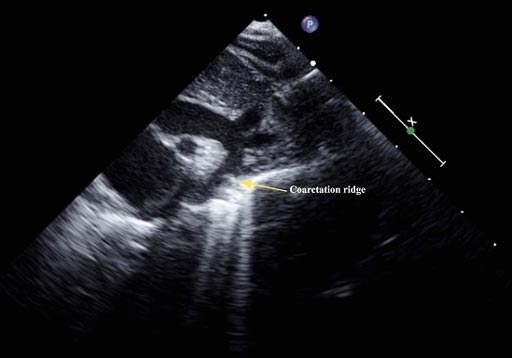Ultrasound Helps Detect Dysfunction Following Coarctation Surgery
By MedImaging International staff writers
Posted on 19 Jan 2017
Echocardiography can non-invasively evaluate deformation of the heart muscle in neonates following surgery for coarctation of the aorta (CoA), according to a new study.Posted on 19 Jan 2017
Researchers at Umeå University and Sahlgrenska University Hospital conducted a retrospective study involving 21 pediatric patients (median age at procedure nine days) with surgically repaired CoA at three time points: just before intervention, at short-term follow-up, and at medium-term follow-up after intervention. The aorto-septal angle (AoSA) was measured from the parasternal long axis view, at three time points – during the cardiac cycle – end diastole, the beginning of systole, and at peak ejection in the descending aorta.

Image: An ultrasound image that shows narrowing of the aorta (Photo courtesy of Haki Jashari).
The results showed that AoSA was significantly wider before intervention, in particular at peak ejection in the descending aorta, and correlated with the CoA pressure gradient, severity of obstruction, left ventricular (LV) dysfunction, and compromised LV global deformation. After the surgical intervention, AoSA normalized, and was significantly correlated with the increase of LV cavity function and overall LV deformation parameters. The study was published on November 22, 2016, in Congenital Heart Disease.
“The best method to assess the impact of aortic coarctation on heart function post-surgery is the non–invasive ultrasound method, equipped with recent echocardiographic modalities. This widely used method is radiation free, inexpensive and patient–friendly,” said lead author Haki Jashari, MD, a PhD student at the Umeå department of public health and clinical medicine. “Our research suggests that patients who have been operated for aortic coarctation should receive lifelong follow-up.”
CoA is a congenital heart disease, where the main artery coming out of the heart is narrowed just after it branches for the upper body. The narrowing results in high blood pressure in the upper body and low pressure in the lower body. Severe cases presented in the neonatal period can lead to heart failure, while mild narrowing may go unnoticed and is often first diagnosed in childhood or even later. Usually by then, the heart has already responded to the increased pressure with wall thickening.














